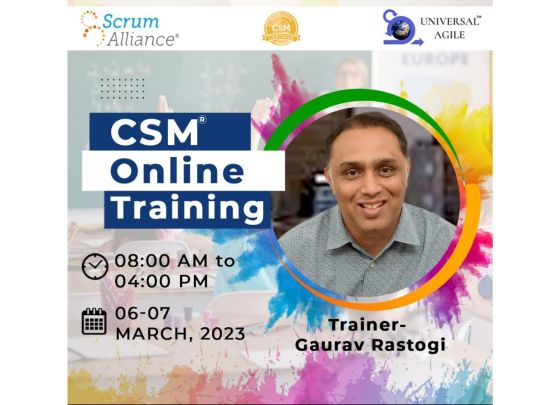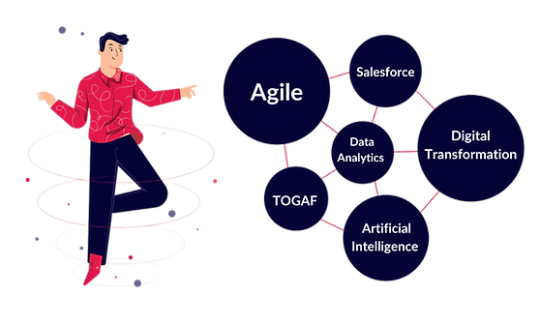#scrum agile certification
Explore tagged Tumblr posts
Text
What are the Rules or Principles of a Scrum Master in Agile?
The Scrum Master in Agile follows core principles and responsibilities:
Servant Leadership: Supporting and serving the team's needs.
Facilitation: Ensuring Scrum ceremonies are productive.
Guardian of the Scrum Process: Upholding and coaching Scrum practices and values.
Continuous Improvement: Advocating for better practices and efficiency.
Shielding the Team: Protecting from external distractions and interruptions.
Promoting Self-organization: Encouraging team autonomy and decision-making.
These principles guide the Scrum Master's actions to ensure the team's success in the Agile framework.

#agile scrum master certification#agile scrum master#scrum master certification#scrum agile certification#agile and scrum certification
0 notes
Text

Last chance to grab the #csm #weekday training and get #scrumalliance accredited #csmcertification delivered by renowned Certified Trainer Gaurav Rastogi, CST
#what is a scrum master certification#how to do scrum master certification#how to do csm certification#agile scrum master certification#scrum agile certification#agile certification cost in india#certified scrum master certification#csm training in kolkata#csm training in mumbai#csm exam practice questions#csm training online#scrum master certification#certified scrum master#cspo certification#how to get agile scrum master certification#scrum master certification course
0 notes
Text
Agile scrum master certificationin Philadelphia
Obtain your Agile Scrum Master certification in Philadelphia to master Scrum principles and practices. Enhance your leadership skills, improve team collaboration, and boost your career in Agile project management.
0 notes
Text
#ProjectManagement#PMP#PMPCertification#CareerGrowth#Leadership#ProjectManager#BusinessSuccess#Agile#Scrum#PMO#ManagementSkills#ProfessionalDevelopment#Certification#ProjectLeadership#CareerAdvancement
0 notes
Text
youtube
Advised Skills: Future-Proof Training for Success Discover @AdvisedSkills - your partner in expert training and consulting for the future. From Agile & Scrum to Leadership Development, gain practical tools and real-world skills to thrive in today’s fast-changing world.
Ready to future-proof your career? Visit www.AdvisedSkills.com!
#advised skills#career#agile#project management#certification#learning#scrum#leadership skills#leadership#teamwork#Youtube
1 note
·
View note
Text
What are the Benefits of Becoming Certified as an Agile Scrum Master
Becoming a certified Agile Scrum Master is a goal many professionals in the agile field aspire to today. Certifications like the Agile Scrum Master are highly sought after because they open doors to exciting opportunities and impressive earning potential for Scrum professionals.
Agile and Scrum are the techniques that make the project entirely more effective. The business can become more agile with the help of adopting Scrum, and it increases the requirement for Scrum masters.
Getting Certified Agile Scrum Master Certification will help you to have all the potential skill sets that the business is looking for in the product scrum master.

0 notes
Text
Greetings!! Be future ready! Unlock Your Future in IT for tech and non tech students and professionals!
1. Study Scrum for FREE! Take the first step towards Agile project management with Udemy course, "Introduction to Scrum (Scrum Guide) With More PSM1 terms". Type course name in udemy site search to access this course.
2. Revolutionize Your Skills with Generative AI & RPA! Get instant access to our exclusive 10-hour course, featuring: - Generative AI - 4 industry-leading RPA tools: Automation Anywhere 360, UIPAth, Blue Prism, and Power Automate - 14 hands-on demos to practice with free AI and RPA tools on your laptop - Unbeatable price: just Rs 399(USD 4.8)! (WhatsApp at 91-9871117072 to get a coupon code for this discounted offer)
Don't miss out on these game-changing opportunities! Enroll now and transform your career in IT! Happy Learning!
#artificial intelligence#agile scrum certification#information technology#low code development#robotics and automation#robotics engineering#robotics for kids#coding#robotics#low code automation
0 notes
Text
Maximizing Career Growth with Scrum Master Courses and SAFe Agile Framework Certification
In today’s fast-paced business environment, mastering agile methodologies has become essential for professionals looking to enhance their career prospects. Scrum master courses and SAFe Agile Framework certification are two pivotal qualifications that can significantly elevate your professional standing in the industry. Whether you are a budding project manager, an experienced IT professional, or someone looking to transition into the agile workspace, obtaining these certifications can provide you with a competitive edge. Understanding Scrum Master Courses
Scrum master courses are designed to teach professionals the fundamentals of the Scrum framework, which is a popular agile methodology used for managing and completing complex projects. These courses cover essential topics such as sprint planning, team collaboration, and backlog management. By enrolling in a scrum master course, you not only learn the theoretical aspects of Scrum but also gain practical insights through real-world case studies and projects. Moreover, scrum master courses are ideal for professionals who want to step into leadership roles within agile teams. As a Scrum Master, your primary responsibility is to facilitate the Scrum process, ensuring that your team follows the principles of Scrum while also protecting them from external distractions. The skills you gain from these courses will help you lead your team to success by fostering a culture of continuous improvement and high performance.
The Importance of SAFe Agile Framework Certification
While scrum master courses focus on team-level Scrum practices, the SAFe Agile Framework certification extends your knowledge to the enterprise level. The Scaled Agile Framework (SAFe) is designed to help organizations apply agile methodologies across multiple teams, departments, and even entire organizations. This framework is particularly beneficial for large enterprises that require a coordinated approach to agile implementation.
Obtaining a SAFe Agile Framework certification demonstrates your ability to scale agile practices beyond individual teams and into broader organizational structures. This certification is highly valued in industries that require synchronization across various agile teams, making it an essential credential for senior agile practitioners, program managers, and portfolio managers. By understanding the intricacies of SAFe, you can play a pivotal role in driving large-scale agile transformations within your organization.
Advancing with Leading SAFe Certification
The Leading SAFe certification is a specialized qualification that focuses on leading agile transformations within an organization. This certification is tailored for leaders who are responsible for guiding their teams through the implementation of the SAFe framework. The Leading SAFe certification equips you with the skills needed to effectively lead and manage multiple agile teams, ensuring that they work in harmony towards achieving the organization’s strategic goals.
This certification is particularly useful for senior managers, executives, and change agents who are tasked with driving agile adoption at an enterprise level. With a Leading SAFe certification, you gain a deep understanding of how to align agile practices with business objectives, foster collaboration across departments, and create an agile culture that supports continuous improvement.
Conclusion
In conclusion, scrum master courses, SAFe Agile Framework certification, and Leading SAFe certification are critical qualifications for professionals aiming to thrive in the agile landscape. These certifications not only enhance your technical expertise but also position you as a leader capable of driving agile transformation in your organization. Whether you’re looking to manage a single team or lead an entire enterprise, investing in these certifications will undoubtedly propel your career to new heights.
0 notes
Text

Unlock your potential with our Scrum Master Training at PMP Academy in Hyderabad! 🌟 Dive deep into the agile world and master the art of Scrum. Our expert instructors will guide you through every step, ensuring you have the knowledge and skills to lead successful projects. Don't miss this opportunity to boost your career and become a certified Scrum Master. Join us now!
#ScrumMaster#ScrumTraining#Agile#PMPAcademy#Hyderabad#ProjectManagement#CareerGrowth#Certification#ProfessionalDevelopment#Leadership#TechTraining#PMPCertification#AgileTraining#HyderabadTech#scrum
0 notes
Text
Agile Expands its reach in future

The Agile Scrum Master certification will continue to be of great importance, so will the position of Scrum Master, as Agile expands its reach. To thrive in such circumstances, interested individuals must adopt changing fashions, exploit technological advances and grow their leadership skills.
#scrum master certification#agile scrum master#agile methodology#agilemethodology#training course#uae training#courses#dubai#training
0 notes
Text
#Agile Scrum Foundation Certification#corporate training#certification and training#agile#scrum#course
0 notes
Text
What benefit does Lean Portfolio Management Certification offer to individuals and organizations?
The Lean Portfolio Management Certification course is considered to be the most respected course in the industry. For individuals, it opens doors to higher-level job opportunities. This course shapes them to be eligible candidates to lead agile teams in a large organization with the necessary understanding of LPM principles and practices. And these courses are designed to support organizations with skilled workforce who understand the needs and goals of a company by taking strategic initiatives.

#agile#scrum master#advance agility#Lean Portfolio Management#LPM Training#LPM Certification#certification#SAFe Training#Agile#agile methodology#agile development
0 notes
Text
With a focus on Agile principles, the Agile Scrum certification equips you with the necessary skills to effectively collaborate, adapt, and deliver high-quality projects using Agile Scrum frameworks.GSDC Certified Agile Scrum Foundation certification is designed to validate your knowledge and understanding of Agile Scrum methodologies.Agile Scrum certification demonstrates your proficiency in Agile and Scrum practices, making you a valuable asset in today's rapidly evolving business environment. The GSDC Certified Agile Scrum Foundation provides a solid foundation for individuals seeking to enhance their career prospects and contribute to the success of Agile-driven organizations.By obtaining this Agile foundation certification, you gain recognition for your expertise in Agile Scrum and become equipped to lead teams, enhance productivity, and deliver customer-centric solutions. Stay ahead in the competitive job market with the GSDC Certified Agile Scrum Foundation, the agile certification that empowers you to thrive in the ever-changing technology landscape.
#casf#certified agile scrum foundation#asf certification#agile scrum best practices#agile scrum foundation#scrum foundation exam#agile scrum foundation certification#agile scrum certification#agile and scrum foundation certification#agile#agile scrum#scrum
0 notes
Text
Advanced Certified Scrum Master (A-CSM) Training | Learnovative
Enhance your Scrum Master skills with Advanced Certified Scrum Master (A-CSM) training from Learnovative. Our A-CSM course is designed to help you master advanced Scrum practices and methodologies, preparing you to take the next step in your Agile journey. Enroll now and become an expert in Agile project management!
The Advanced Certified Scrum Master (A-CSM) Training provided by Learnovative is a highly regarded Scrum certification offered by Scrum Alliance. As an authorized Registered Education Provider (REP), Learnovative conducts A-CSM Training in both physical classroom and live virtual modes. Our physical classroom training is available in major cities across India, including Bengaluru, Hyderabad, Chennai, Delhi, Kolkata, Mumbai, Pune, Gurugram, and Kochi.
call now : 099499 94949
#A-CSM Training#Certified Scrum Master#Scrum Master Certification#Agile Training#Learnovative#CSM#CSPO#ACSM#ACSPO#CSMtraininginHyderabad#CSMtrainingcoursesinHyderabad#ScrumMastertraininginHyderabad#ScrumMastercertificationinHyderabad#CertifiedScrumMastercertificationinHyderabad#CertifiedScrumMastercertificationtraininginHyderabad#CSMcertificationinHyderabad#CertifiedScrumTrainerinHyderabad#CertifiedAgileScrumTrainerinHyderabad#CertifiedEnterpriseCoachinHyderabad#CertifiedTeamCoachforCSMinHyderabad#CertifiedTeamCoach#CSPOinHyderabad
0 notes
Text

0 notes
Text

Agile Scrum Master Certification in Philippines | Spoclearn
Enroll for Spoclearn Agile Scrum Master Certification in Philippines to gain a comprehensive understanding of championing business agility in the organization and delivering real business value. By attending this 2-day Agile Scrum Master course, participants will also learn the Agile way of thinking, understanding the Scrum Master role, Agile Estimating, planning, monitoring, control, nature of complex projects, and Adopting Agile.
Phone Number- (908) 2937144
Website- https://www.spoclearn.com/ph/
Email Address- [email protected]
0 notes